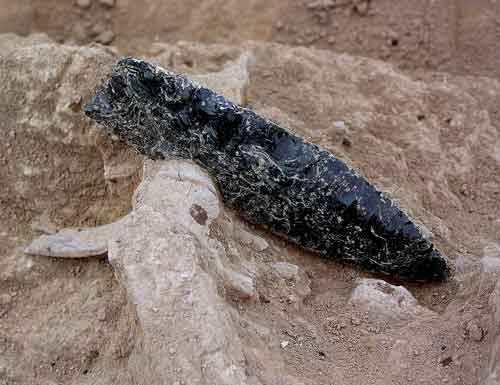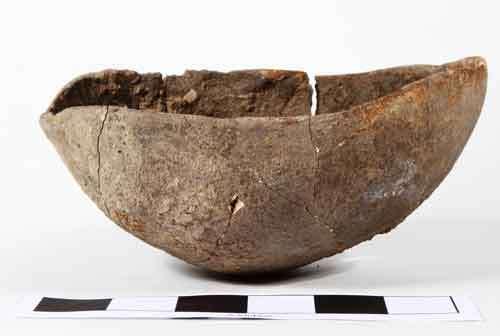Blake de Pastino
Source - http://westerndigs.org/from-stone-darts-to-dismembered-bodies-new-study-reveals-5000-years-of-violence-in-central-california/
From shooting their enemies with darts and arrows to crushing their skulls and even harvesting body parts as trophies, the ancient foragers of central California engaged in sporadic, and sometimes severe, violence, according to a new archaeological study spanning 5,000 years.
In an effort to understand life and death in one of the ancient West’s most populous regions, anthropologists conducted a landmark study of its dead, cataloging signs of violence found in burials between the Sierra Nevada and the San Francisco Bay, dating from historic times all the way back to 3000 BCE.
After 13 years of mining the data, the researchers identified what they say is a complex pattern of episodic violence, driven by forces as diverse as competition for territory, pressure from a changing climate, and the arrival of Europeans.

Remains found in Contra Costa County, California, included a projectile point embedded in the bone. The burial was dated to between 500 amd 1500 BCE. (Photo by Randy Wiberg)
Chronicling 16,820 burials from 329 sites among 13 different ethnographic groups, the data reveal that the most common type of violence over the millennia was so-called sharp-force trauma, caused by projectiles like arrows or atlatl darts, which appeared in 7.2% of the burials studied.
Another 4.3% of the hunter-gatherers suffered apparent blunt-force trauma to the head, while just under 1% showed evidence of dismemberment, with limbs, scalps, or heads having been removed after death.
These grim findings illustrate the periodic conflicts that took place among California’s prehistoric groups in response to the historical, environmental, and social circumstances around them, said Dr. Terry Jones, an anthropologist at Cal Poly who co-authored the new study.
“Many people still seem to think that prehistoric California was a violence-free paradise, but the archaeological record shows clearly that that was not the case,” he said in an interview.
“People are people, and most of us believe that an inclination to resort to violence in certain situations is part of the human condition.”
Jones and his colleague, co-author Al Schwitalla, initially set out to determine whether any rise in violence corresponded with the centuries-long series of droughts known as the Medieval Climatic Anomaly, which persisted from about 800 to 1350.
“I had found evidence in central California for apparent responses to the droughts, in the form of breakdowns in trade relations, changes in subsistence, and shifts in settlement practices,” Jones said.
“But the skeletal record from central California had not been examined relative to this question.”
While changes in climate patterns likely served as an undercurrent of the region’s prehistoric conflict, the results instead revealed two spikes in violence both before and after the droughts.
The first, and arguably more gruesome, episode spanned from 500 BCE to 420 CE, when dismemberment and trophy-taking appeared to peak.
With about 2% of the burials from this period exhibiting dismembered remains, the practice didn’t appear to be commonplace, the authors note, but it did seem to “reflect a strategy of raiding, inter-group retribution, and mutilation for the purposes of intimidation.”
This early period also saw the first major increase in projectile-based violence, perhaps, the authors note, coinciding with the introduction of the atlatl dart-thrower.
ndeed, the pair points out, this thousand-year-span appeared to be a tumultuous time throughout all of ancient California, as many hunter-gatherer groups migrated to new grounds, and new ones arrived from the east.
A particular “hot zone” during this period was the southern San Francisco Bay Area, Jones said, where several cultural complexes — such as the Windmillers, the Early Bay, and Berkeley groups, among others — interfaced, overlapped, and attempted to define their boundaries in a process that “was not entirely peaceful.”
“Ethnic violence seems to have been a factor in prehistoric California, as an early increase in violence seems related to the arrival of new peoples,” Jones said.
The second spike in violence detected in the skeletal remains took place much more recently, during the early historic period from 1720 to 1899.
Here, injuries by sharp projectiles were far more frequent here than at any other time — evident in about 10% of the sample — due in large part, the researchers say, to a new technology.
“The introduction of a new weapon system — the bow and arrow — definitely changed the social and political landscape, increasing inter-group conflict,” Jones said.

This calvarium, or human skullcap, was modified for use as a bowl. It was discovered among a number of burials in Contra Costa County, California. (Photo by Al Schwitalla)
Previous research has suggested that the bow and arrow first arrived in central California from the east, perhaps as late as 1200 CE, and likely took centuries to become used widely.
But this second spike in violence was also “almost certainly” inspired by the arrival of Europeans, Jones noted, with the first permanent settlement having been established in the 1760s.
“Violence did not begin in California with the arrival of Europeans — although it did increase at that time,” Jones said.
In addition to direct confrontation with the colonizers, the arrival of Europeans likely caused a “rippling effect” of conflict, he added, as groups began to migrate away from the violence, disease and social upheaval that it brought.
The frequency of projectile injuries at this time showed up most often in the foothills of the Sierra Nevada, approaching 25% in the burials sampled there, and figuring prominently among the bands of the Sierra Miwok.
Throughout the 5,000-year survey, the researchers also note, evidence of violence was almost always more often common in men than in women — with the notable exception of blunt-force trauma.
“Females also on occasion participated in combat with neighboring tribes and colonizers, although to a lesser degree relative to males,” Jones reported.
Indeed, rates of head trauma were only slightly less common in women than men — 4% of females, versus 5.5% of males — an observation perhaps supported by the many historic accounts of women taking up arms alongside men in the Miwok, Costanoan, and Patwin, among other groups.
Taken together, Jones said, their data portray periodic bouts of inflamed violence among Central California’s ancient indigenous groups, rather than a long, steadily increasing trend.
But violence was always present, despite what Jones sees as a tendency by modern historians and anthropologists to overlook native conflict.
“It seems that everyone wants to envision some Eden-like period in the past when there was less violence,” he said.
“Violence is an uncomfortable topic, especially for some Native American descendants. Certain naive environmentalists also seem to want to cling to the notion of prehistories free of any social or ecological ills.
“But archaeologists have an obligation to report what the record reveals. What is abundantly clear is that prehistoric California was populated by intelligent, skilled, anatomically modern human beings who certainly were not savages but nor were they necessarily noble — they were people — subject to the same range of emotions and behavioral responses as other human populations.”
Jones, Schwitalla, and their colleagues detail their findings in the Journal of Anthropological Archaeology.